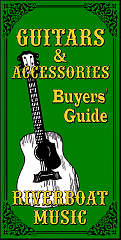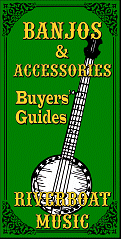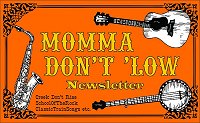
Pick up any old thing and join in!
| Please Read: How to Help Our Site at No Cost to You - Some of our articles contain recommendations for products we like and vendors we personally trust. Some of those vendors may pay us a very small commission if you click on a link and buy their products. This costs you nothing at all and helps offset the costs of what we do. So if we point you to something you decide to buy later, please make certain you come back through our site and click on the link directly. Thanks. |
| This Site is a Cookie-Free Zone - Except for discussion forums that you have to expressly register for, none of our pages use cookies of any kind. Some of the vendors we link to do, but that won't affect you unless you click on a link to their pages. Your continued use of this page indicates that you agree to our policy. For details, click here. |



|


What "Folk Songs" Should I Know or Know About?
This is part of the "How To Folk" series of articles. In an effort to "jump start" your enjoyment of Folk music (and maybe reduce culture shock), we have provided a brief introduction to the kinds of songs and songwriters that embody "Folk" for most people interested in such things. .
Woody Guthrie's "This Land is Your Land" (as recorded by the Weavers) was the unofficial anthem of the Folk Revival, closing out most hootenannies and many concerts for decades, because everyone could join in. Pretty much anyone who is remotely interested in Folk music needs to know that song.
Beyond that, it's important to remember that the "Folk Revival" and its influence stretched over parts of six decades. So, to some extent, what "Folk Music" means may depend on the age of the person who is talking about it.
Folk Song Eras
Folk singers and fans of each era had their own favorite songs. And in each era, most Folk musicians knew those songs well enough that they could join in on any of those, knowing nothing more than the key of the song.
Note: - No one knows all of these eras equally well. In fact, folks who "cut their (musical) teeth" in one era might believe that the Folk music they first learned to love is the only kind that really "counts." When you encounter them, be kind. :-) On the other hand, everybody has preferences; and that's to be expected, as long as everyone else's taste is respected.
- 1920-1930s The world began to notice the Folk Song collectors like Alan Lomax and John Jacob Niles, who were collecting and publishing folk songs from out-of-the-way regions, forgotten prison populations, and other obscure sources.
In 1924, Vernon Dalhart's successful recording of "The Wreck of the Old '97" opened the door for countless "roots" musicians of various cultures, including the Carter Family.
Woody Guthrie, Pete Seeger, and others were jamming and singing protest songs anywhere they could protest against war, racism, or brutal treatment of workers.
- 1940s-1950s - Pete Seeger and three others formed the Weavers and recorded songs like "Goodnight, Irene," "Follow the Drinkin' Gourd," and "Michael Row the Boat Ashore."
Founding Weaver Pete Seeger added folk-like originals such as "Where Have All the Flowers Gone," "If I Had a Hammer," and "Kisses Sweeter than Wine."
- 1950s-early1960s - The Kingston Trio era added songs like "Tom Dooley" and "Sloop John B" (later recorded by the Beach Boys and countless others).
Joan Baez, Buffy St. Marie, Ed McCurdy, Cisco Houston, and many others were recording traditional tunes like "Barbara Allen," "Crawdad," "Old Joe Clark," "Cindy," "Old Dan Tucker," "Cripple Creek," "Pretty Polly," and more.
Folk songs like "Crawdad" and "Betsy from Pike" found their way into elementary school music primers.
Gordon Lightfoot recorded "Early Morning Rain " and "That's What you Get for Lovin' Me."
Bob Dylan added "Blowing in the Wind," "Don't Think Twice," and countless others.
Ian and Sylvia (Tyson) added "Four Strong Winds."
And so on, through Peter, Paul and Mary, the early work of Simon and Garfunkle, and many more.
As well as a hundred others whose songs left their mark. (If I left out your favorite artists, don't feel bad; I had to leave out several of mine as well.)
- Late 1960s - Many whose careers had emerged by 1964 continued to tour and record, but the British Invasion pushed them off the radio for the most part.
Folk-Rock emerged - Folk-influenced music with drums and electric guitars. Examples: The Byrds, Donovan, and - to some extent - the Mamas and Papas.
- 1970s and Later - Long after Rock and Roll was dominating the airwaves, Folk-influenced singer-songwriters like James Taylor, Cat Stevens, Jim Croce, and Harry Chapin were still writing songs that were being labeled "Folk," because no other genre label came close. And a few of those songs were heard on the radio. However, by then, the "Folk scene" had pretty much shut down, so amateur guitarists were no longer flooding coffeehouses or other venues to jam on, say, "Fire and Rain," "Wild World," "Time in a Bottle," or "Cat's in the Cradle."
In 1970, songwriter Steve Goodman wrote "City of New Orleans," which became a big hit for Arlo Guthrie (son of Woody) in 1972.
Also, many rock artists who grew up during the Folk Revival era include Folk-style songs on their records. CSN's "Teach Your Children," Eagles' "Desperado," and countless others.
Folk-influenced tunes that came out during the '70s Rock era still turn up in "Folk jams" today. And for many people, such songs were their first introduction to the Folk genre. Being lucky enough to grow up with the Weavers and the Kingston Trio doesn't give you permission to judge folks who grew up with Arlo and Sweet Baby James. Or vice versa.
You don't have to know all the songs I just listed. Or even most of them. But it would be helpful to listen to a sample and get a sense of how they "worked," so if you attend a jam or some such function, you're not lost completely.
Above all, I list these songs and artists out to give you an idea of just how wide the "Folk" genre stretches, from pure traditional songs gathered in the wild to Folk-influence songs played with electric guitars and drums, stretching chronologically over parts of six decades. "Folk" also stretched musically to include Spirituals, Calypso, Eastern European ballads, Spanish, Mexican, Yiddish, and more.
About "Covers"
Before the Beatles gained a reputation for writing most or all of the songs on their records, it was normal for record producers to stack LPs with great songs that had already been recorded by someone else. These were called "covers."Two originals per album - or maybe three - were typical. So producers would come up with a long list of proven hits that they thought their artist(s) could do justice to, as a way of making certain buyers enjoyed the record from beginning to end. That approach contributed to overall LP sales, which was where the "real money" was in those days.
Fortunately, the great songwriters of the Folk Revival era seriously appreciated the work of the other great songwriters of the era, and didn't mind sharing and borrowing. As an example, Lightfoot's "Early Morning Rain" was covered credibly by countless other first-tier artists, including Ian and Sylvia, Judy Collins, Peter, Paul, and Mary, and even Bob Dylan, who never had a problem filling up an album with his own material.
Sometimes the "cover" became better known than the original, as did Steve Goodman's "City of New Orleans," which was a huge hit for Arlo Guthrie.
Sometimes the "cover" was just enough different from the original that if you were leading a sing-along, you would have to say, "We're going to do the such-and-such version." As an example, the Peter, Paul, and Mary version of "500 Miles" is much slower than composer Hedy West's original recording. Most serious Folk fans would know both versions, and anyone who understood Folk conventions would be glad to follow along, even if they had never heard the other version.
About "Versions"
Many traditional songs came down to us in different, but equally authentic versions. Ballads and barn dance tunes, especially, have accumulated so many different verses over the years, that part of each performance is deciding which verses to sing, to sing next, or to leave out altogether.In addition, many folksingers added their own "tweaks," such as modernizing the lyrics, adding chord changes, or outright changing the tune. For example, Peter, Paul, and Mary gave "This Train Don't Carry No Gamblers" an entirely different feeling when they changed it to a minor key. (Interestingly, "This Train" returned to Gospel circles in that version, as recorded by the Staples Singers.)
Other songs, like "Man of Constant Sorrow," have changed so many times over the years that any group doing them has to decide which tune to use.
A few artists, like Chad Mitchell, were known for rewriting traditional songs so completely that they qualified as original compositions ("Golden Vanity" is one example). That said, Mitchell made certain his versions still maintained Folk conventions.
Even Folk-influenced songs by mid-century writers were occasionally rewritten (usually with the original composer's consent.)
Once again, every fan of Folk music has the right to prefer his or her version of a song; no one has the right to tell you it's the only "correct" version. If Gordon Lightfoot was okay with Judy Collins raising the tempo and changing a line in "Early Morning Rain," you should be, too.
About "Gospel"
In the early days of the Folk Revival movement, traditional Gospel music, especially "Spiritual"-style songs were an important part of most artists' repertoire.As an example, one traditional song, "You Can Tell the World," was recorded by any number of artists, including the Chad Mitchell Trio, Simon and Garfunkel, the Limeliters, the Tarriers, the Seekers, and Peter, Paul, and Mary.
That song and others, like "Were You There When They Crucified My Lord?," "Wait on the Water*," and many more were almost a "right of passage" for anyone wanting to earn serious "cred" as a Folksinger.
Several artists wrote songs in similar style with religious or Biblical themes. Noel Stookey's "Early in the Morning" uses the same I-IV-I-IV progression as "You Can Tell the World," as well as apocalyptic themes from spirituals like "When the Saints Go Marching In." Chad Mitchell's "Run, Run, Run," uses lines about Bible characters to promote a social justice message.
Traditional Gospel artists like the Clara Ward Singers were even invited to participate in Folk music festivals.
Unfortunately, since those days, right-wing extremists have been increasingly claiming that their tendency to be misogynists, haters, and bigots is supported by the faith they claim (it isn't). One result is that Gospel tunes are no longer as welcome in some Folk circles as they once were. On the other hand, I'm sure there are lots of people my age who think I'm betraying "their side" because I still write and sing songs that promote the same kind of compassion and social justice that was preached by Jesus and most of the Old Testament prophets.
For my part, I try to live, write, teach, and sing in a way that closes the gap. Pete Seeger did just that, and we need that spirit even more today.
Other Resources
This section will list other Folk song resources as we come to them. Current resources include:- What are Folk Songs? - A brief overview of several classes of music that have brought joy to millions.
- Old Timey Song Sheet - a two-page handout with the words and chords for several 2- and 3-chord Folk songs in the keys of G or D.
- What is Folk Music? - A much-expanded version of our "What are Folk Songs" article, on our CreekDontRise.com site.
- What Was the Folk Revival? - A look at the rise of the mid-20th-century Folk movement and its effects on other genres, from our CreekDontRise.com site.
- More to come
Conclusion
This is just an overview of the kinds of songs and - to some extent - people you're likely to encounter if you begin dabbling in Folk music. To people outside of the community, we may seem to be working with self-imposed limitations, or stuck in the distant past. But if you listen to a sampling of the songs I've listed above, you'll realize that there is incredible variety and depth to the genre. And room for all sorts of creativity.Wherever you are in your journey, welcome aboard.
*The traditional spiritual "Wait On the Water" was related to a popular superstition reported in John 5:4 that an angel would occasionally stir up the water in the Pool of Bethesda, and whoever plunged into the water first would be healed. In Pentecostal circles, this was taken as a metaphor. "Wait on the Water" meant, essentially, "Be ready to exercise faith when you sense that the Spirit is moving." As the song aged, its connection to John 5:4 was forgotten, and "Wait on" became "Wade in."
Sister Sites
 Other sites we started to keep this site from getting too big to be useful include:
Other sites we started to keep this site from getting too big to be useful include:
- CreekDontRise.com is a repository of articles about Folk music and the instruments on which it has been traditionally played.
The "Acoustic" page includes a long list of articles including maintenance and playing tips on all sorts of traditional acoustic instruments.
 RiverboatMusic.com is a buyers' guide for acoustic and traditional instrument from a musician's point of view, focusing on the uses, reliability, and practicality of various instruments, and not just the marketing hype about the shape of the fret markers or whatever.
RiverboatMusic.com is a buyers' guide for acoustic and traditional instrument from a musician's point of view, focusing on the uses, reliability, and practicality of various instruments, and not just the marketing hype about the shape of the fret markers or whatever.
For instruments like dulcimers that have mostly small manufacturers or cheap imports, we try to tell you what to look for, irrespective of brand.
 Momma Don't 'Low includes a free e-mail newsletter that discusses all of those topics above and more. We plan to include other features as time permits.
Momma Don't 'Low includes a free e-mail newsletter that discusses all of those topics above and more. We plan to include other features as time permits.
Note - If you wish to sign up for our newsletter and ask a question at the same time, please click on the Momma Don't 'Low newsletter button to learn more and to get a link to our signup form.
 PaulRaceMusic.com is the "landing page" for Paul's own musical endeavors, plus many memoirs and blogs about music and the music business.
PaulRaceMusic.com is the "landing page" for Paul's own musical endeavors, plus many memoirs and blogs about music and the music business.
 ClassicTrainSongs.com describes railroad songs that every train lover should know. Or at least know about.
ClassicTrainSongs.com describes railroad songs that every train lover should know. Or at least know about.
- SchoolOfTheRock.com has articles about Christian music, Christian music careers and performance, Christian living in general, and vintage saxophones, another of Paul's interests. This site has separate newsletters, etc., by the way - there isn't a lot of overlap with the Momma Don't 'Low(tm) newsletters.
For information about other music collections and projects, check the links at the bottom of this page.
 Whatever else you get out of our pages, I hope you come away with some great ideas for "sharing the joy."
Whatever else you get out of our pages, I hope you come away with some great ideas for "sharing the joy."
And please stay in touch!
All material, illustrations, and content of this web site is copyrighted (c) 2001, 2002, 2003, 2004, 2005, 2006,
2007, 2008, 2009, 2010, 2011, 2012, 2013, 2014, 2015, 2016, 2017, 2018, 2019, 2020, 2021, 2022, 2023 by Paul D. Race. All rights reserved.
Creek Dont' RiseTM is a participant in the Amazon Services LLC Associates Program, an affiliate advertising
program designed to provide a means for sites to earn advertising fees by advertising and linking to Amazon.com.
For questions, comments, suggestions, trouble reports, etc. about this page or this site, please contact us.
| Visit related pages and affiliated sites: | |||||
| - Music - | |||||

|
 |
 |

|

|

|

|

|

|

|

|

|

|

|

|

|

|

|
| - Trains and Hobbies - | |||||
 |

|

|  |
 |

|
| - Christmas Memories and Collectibles - | |||||
 |

|
 |

|
 |

|
| - Family Activities and Crafts - | |||||
 |

|

|

|

|

|

